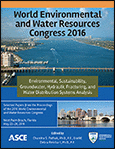Preliminary Assessment of Groundwater and Surface Water Characteristics in the Upper Chao Phraya River Basin Land Using a Stable Isotope Fingerprinting Technique
Publication: World Environmental and Water Resources Congress 2016
Abstract
Water stress is rapidly increasing in many parts of Thailand, especially during drought season, due to expansion in agriculture and industry. This study is focusing in the Upper Chao Phraya river basin to assess the capability of using water stable isotope analysis (δD-δ18O) to refine the understanding on spatial and temporal distribution of precipitation as well as the surface water-groundwater interactions for the aquifer systems underneath the study area. Local precipitation, surface water, and groundwater are sampled along the main river courses and their tributaries. Massive precipitation isotopic composition database from IAEA existing monitoring network (GNIB) along with local Bangkok precipitation isotope signature are compared with precipitation from Chiang Mai province in the North of Thailand to better identify the rainfall isotopic compositions. In addition to the isotopic distinction of precipitation in the area, its impacts on isotopic signature of surface water and groundwater are additionally explored. LMWLs for local rainfall in Bangkok and Chiang Mai are generated with some seasonal variation of rainfall isotope signature due to rain out effect. Surface water in the study area is influenced by evaporation at some degree, revealing that rainfall may not be the primary source of surface water. Yom river’s isotope signal values are far more D and 18O-enriched compared to Ping’s and Nan’s, suggesting the mixing of groundwater into river water and/or the origin of surface water may come from dry-period precipitation. Stable oxygen and hydrogen isotope data in groundwater again fall on an evaporation line, and is thus indicative of the effects of high evaporation rates through the top surficial material. The isotopic similarity with the more depleted δD and δ18O of groundwater samples suggests the potential mixing of groundwater with river water by different mixing processes (54% from river water and 46% from rainfall). The results of stable isotope analyses show correlations in the isotope signature of shallow (i.e., < 50 m deep) and deeper aquifer (i.e., > 50 m deep) which may be associated with hydraulic connection and/or similar hydrogeological conditions. d-excess stable isotope analyses are beneficial to identify the relative contributions of the wet and dry seasonal sources to the groundwater recharge. The results indicate that groundwater sources in the area are composed of an average of approximately 71.4% wet seasonal sources and 28.6% dry seasonal sources.
Get full access to this chapter
View all available purchase options and get full access to this chapter.
Information & Authors
Information
Published In
Copyright
© 2016 American Society of Civil Engineers.
History
Published online: May 18, 2016
Authors
Metrics & Citations
Metrics
Citations
Download citation
If you have the appropriate software installed, you can download article citation data to the citation manager of your choice. Simply select your manager software from the list below and click Download.
